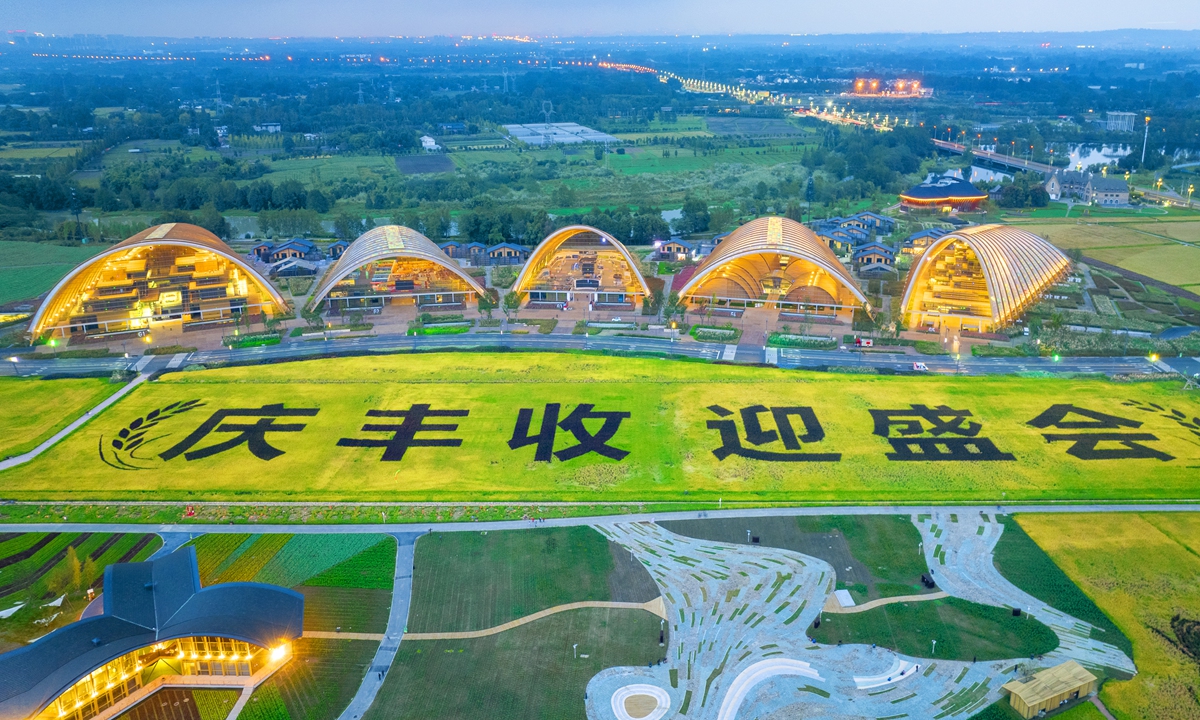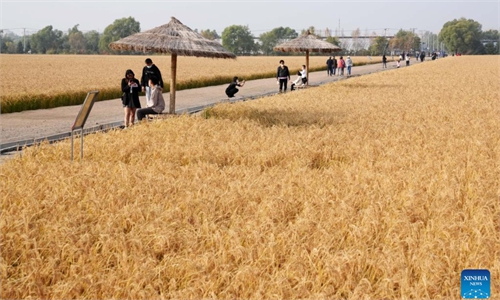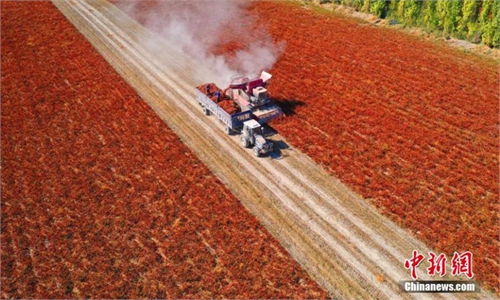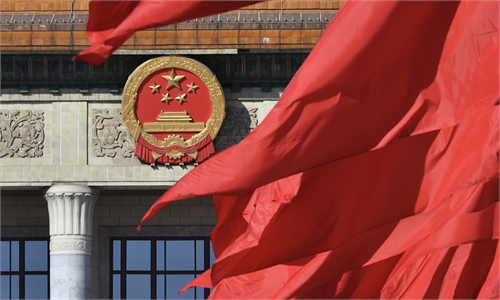
A picture taken on October 7, 2022 shows a rice field in Chengdu, Southwest China's Sichuan Province. The Chinese characters read "Celebrate the bumper harvest, welcome the grand event," as the 20th National Congress of the Communist Party of China is scheduled to convene on October 16. Photo: VCG
Despite the unprecedented heat and drought that plagued the south of the country this summer, China's autumn harvest is in full swing, completing 672 million mu (44.8 million hectares), more than half of all the farmland across China grown with autumn plants, as of Saturday, with several major grain production areas seeing a significant increase.
Experts said that while parts of the country had been affected by the extreme weather, China would still see a bumper harvest this year thanks to the application of more advanced agricultural technologies and timely policy adjustments and incentives. At a time when global food security is in disarray, maintaining stable grain production is a major contribution that China has made to the world, they noted.
Data from the Ministry of Agriculture and Rural Affairs showed that the country's autumn harvest has been advancing at 35 million mu per day, completing 51.5 percent of the total so far, 3 percentage points faster than the same period last year.
Main grain production areas have now entered the harvesting season. "This year, the northeast, the Yellow River-Huaihe River-Haihe River areas, and the northwest of China have seen good grain growth. Corn, rice, soybean yields have increased to varying degrees, and the autumn grain is expected to see a bumper harvest," Zhu Juan, an official with the ministry, told People's Daily.
In addition, 6.9 percent of winter wheat has been sown nationwide, and 17 percent winter rape has been sown, latest data from the ministry showed.
Grain production this year has been particularly difficult for farmers nationwide for various reasons, from rare autumn floods in the north last year that forced large scale late sowing of winter wheat, to the highest temperatures in more than 60 years this summer that resulted in a significant drop in rainfall in the Yangtze River basin.
To address these challenges, the Ministry of Water Resources launched a special operation for water supply in the Yangtze River basin to combat the drought, transferring water from upstream reservoirs to water-scarce areas in the middle and lower reaches, thus securing the irrigation needs of autumn grain, according to media reports.
The Global Times spoke to several farmers in East China's Zhejiang Province. A farmer surnamed Hu from the Ninghai county in Zhejiang told the Global Times on Saturday that production this year is expected to be reduced mainly due to the drought. Another farmer who requested anonymity said the local government has given some financial support such as helping them with irrigation to ease the problems caused by the extreme weather.
"High temperatures and drought this year may reduce yields in some parts of the country, but many other regions unaffected by the extreme weather are expected to increase yields, so it is expected that China will still have a good harvest," Li Guoxiang, a research fellow at the Rural Development Institute, Chinese Academy of Social Sciences, told the Global Times on Saturday.
Food security is among China's most fundamental interests, and the country has paid paramount attention to it and put in place precautions, considering the potential risks including extreme weather, Li said.
China has focused on the construction of high-standard farmland and water conservancy and irrigation facilities for many years, which has played key roles in reducing the adverse effects of drought, according to Li.
China has also introduced policies to boost grain production this year including issuing one-time subsidies for farmers, to stabilize their income and incentivize farmers to grow grain.
Thanks to the strenuous efforts to ensure food production, China's summer grain production increased by 2.87 billion jin (1.435 billion kilograms), early rice production saw an increase of 210 million jin, and autumn grain areas are seeing better crop growth than in the previous year, according to data previously released by the ministry of agriculture.
This year's annual grain production is expected to stabilize for the eighth consecutive year at more than 1.3 trillion jin in total, China Central Television said.
In the past 10 years, the total national grain output increased from 1.245 trillion jin in 2012 to 1.365 trillion jin in 2021, with per capita grain possession reaching 483 kilograms, compared with the internationally recognized 400 kilograms grain safety line, according to media reports.
Global food supply has been impacted by a series of factors including the COVID-19 pandemic, extreme weather, and the Russia-Ukraine conflict this year. As the grain production situation deteriorates, many believed that the global food crisis has already occurred.
According to the UN World Food Program, the number of people affected by hunger increased to 828 million in 2021, and the world is getting farther away from the goal of "eliminating all forms of hunger, food insecurity and malnutrition by 2030."
Food prices are highly volatile around the world, but China has managed to maintain stable production and thus a relatively stable price at a time when global food security is in disarray, experts noted.
In the food consumption field, Chinese residents can afford them at stable prices across the country, as the government can ensure that grain supply is fully guaranteed, Li noted.
"The biggest contribution China has made to the international community is that we have reduced imports when global prices went through sharp fluctuations, thus enabling the prices to come back down," the expert said.



